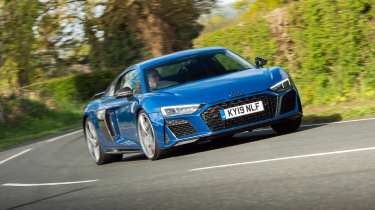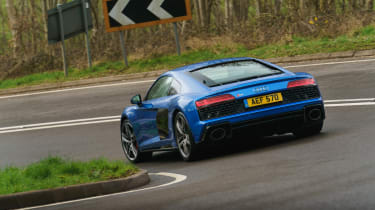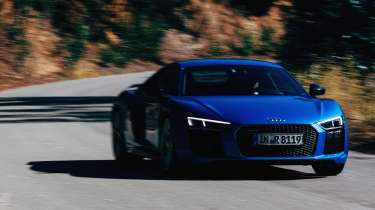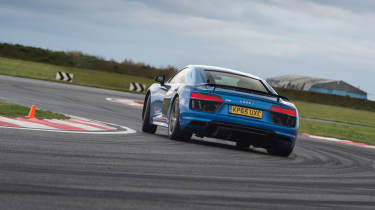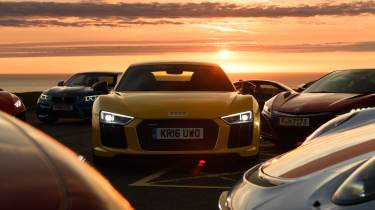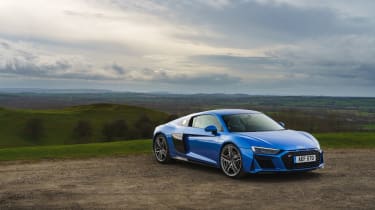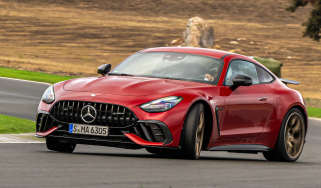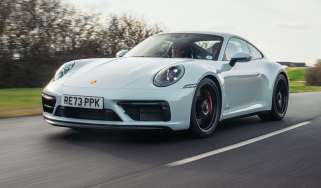Audi R8 (2015 - 2024) review – the ultimate soft-focus supercar
The second Audi R8 saw what was an exotic sports car become a full-blown supercar to rival McLaren, Porsche and Maserati
The Audi R8 got serious for its second generation, first revealed in 2015. The Porsche 911 Carrera S-rivalling V8 went unreplaced, with the R8 becoming what the V10 variant of the first car initially explored – a full-bodied Audi supercar to battle the Porsche 911 Turbo and McLaren 570S.
The least powerful version, called Audi R8 V10, had ‘just’ 533bhp but at the time, was more than a 100bhp jump over the last entry-level car. The R8 V10 Plus launched as the flagship with a full-bodied 602bhp and 413lb ft – the first production Audi to breach the 600bhp barrier. Combine that with a seven-speed dual-clutch transmission and all-wheel-drive, and the result was more performant than some hypercars of a decade prior – 0-62mph in 3.2sec, on the way to a 205mph top speed.
Yet in spite of its push upwards into exotica, the R8 did not abandon one of its core tenets and most appealing talents – approachability and usability. Its V10 is entirely docile at low speeds, as is its dual-clutch transmission. Its steering is light, the ride is well-judged (in both active and passive cars), the view out is great and the boot is big. Inside, at the risk of sounding redundant, it’s an Audi, which is to say quality is great and everything’s logical and works, though it does lack a bit of design ‘flare’ for a supercar.
More reviews
Group tests
In-depth reviews
Reviews
- Audi R8 Spyder (2016 - 2024) review – that V10 in surround sound
- Audi R8 V10 RWD and R8 RWD Performance (2020 - 2024) review – Audi's 911 GT3 fighters
- Audi R8 V10 GT RWD (2022 - 2024) review – the R8 bows out in spectacular style
- Audi R8 4.2 FSI V8 quattro (2007 - 2015): review, history and specs of an icon
But that’s almost the point of the R8. Because never in its two generations and 17 years on sale, did the R8 deviate from its role as the perfect gateway supercar. There were always weirder, more wonderful, esoteric cars available, but that simply would not cater to as wide a range of tastes as the R8.
As with the first generation, Spider versions were available but new additions included a succession of rear-wheel-drive versions. The RWS was a 999-of limited-run special based on the pre-facelift car, with the RWD and RWD Performance following once the car was updated in 2019. All but the RWD had the 533bhp version of the V10, bar the RWD Performance, which as the name suggests, had a bit more power, at 562bhp. The limited-run R8 GT RWD was a pseudo GT3 rival – an R8 taken to the (still relatively restrained) extreme, with revised aero and optional coilover suspension.
The all-wheel-drive R8 V10 Performance is the version of the facelifted car that’s most common and most powerful. The flagship used the same 611bhp version of the V10 as was used in the R8 GT RWD. It’s also the fastest – 0-62mph in 3.1sec – even if it was only fractionally faster, as it was only fractionally more powerful, than 2015’s R8 V10 Plus.
What will always loom over the second-generation R8 for those who have spent enough time in the first, is that it’s just a bit colder, a bit less interactive and a bit less adjustable. It’s just less fun than the car it replaced. The steering has always been a bone of contention, the adaptive rack robbing it of feel and cohesion and the passive rack erring on the slow side. The updated car revised the steering with added precision, if not improved feel. The chassis balance has always been more buttoned-up than you’d hope, in the AWD cars at least, though it did improve with the 2018 update. Nevertheless, it does feel like the RWDs were added to the range to cater to those wishing to play a more active role in traction management.
Things got better over the years and with the rear-driven cars, the V10 Performance and the GT RWD, the R8 did reach peaks of appeal. But for all the extra power, all the upward pushing well into the supercar space, it lost the original R8’s very best lovable sports car qualities.
Another elephant in the room with the R8 will always be the R8 e-tron, up there as perhaps the ultimate ‘will they, won’t they’ model of the 2010s. After seeing a number of prototypes clothed in gen-1 R8 bodies, we really thought a production car would happen when a version of it was revealed on day one for the second-gen car in 2015. Then, quite quietly it seemed, it died off. Perhaps demand wasn’t there, perhaps Audi wasn’t happy with the technology as it stood, but the R8 e-tron was always a car before its time for Ingolstadt. Contrast this to the R8 V12 TDI, which very much was a car of its own time and no other, but we digress…
Audi R8 in detail
- > Engine, gearbox and technical specs - A 5.2-litre V10 engine is the jewel in the R8’s crown, perfectly matched to a slick dual-clutch box
- > Performance and 0-60mph time - It might lack turbos or an ocean liner-like torque figure, but the R8’s performance is still stunning
- > Ride and handling - Huge grip and adjustability make the R8 a joy to drive, with the hardcore GT RWD adding more bite and precision
- > MPG and running costs - Fuel consumption is not a strong point, but then long runs can squeeze over 25mpg, which realistically is about what a super saloon is able to achieve
- > Interior and tech - The R8's cabin feels refreshingly simple. Intuitive controls and no screens tacked onto the dashboard have timeless appeal
- > Design - This is where the R8 falls down, as the second take on the original R8’s innovative aesthetic is contrived and sometimes awkward
- > Living with one - evo editor Stuart Gallagher had the tough job of finding out what six months of Audi R8 Performance ownership was like...
What we said
‘To be clear, I wasn’t expecting armfuls of corrective lock and clouds of tyre smoke from the 2015 R8. But in the old model, you could play with the chassis balance and feel it squirming around a little at perfectly reasonable speeds. It was one of the things that made it so much fun. There’s no doubt the R8 is seriously quick and properly sorted, but the optional Dynamic Steering costs it some of the crispness of the old car and that more efficient four-wheel drive system has made the car less expressive.’ – Dan Prosser, 2015.
‘The fixed-rate dampers strike a perfect balance between making the R8 useable everyday, but keeping everything under control when the pace increases. There is actually a surprising length to the travel, which gives the car real grace and composure when you’re pushing hard down a bumpy road. Combined with phenomenal grip, it allows you to attack B-roads with something approaching the abandon you would in a hot hatch although it’s demeanour errs towards secure rather than playfully adjustable.’ – Henry Catchpole, 2017
‘If you notice anything with the updated car it’s the quickness of the steering, particularly with the Dynamic set-up that changes ratio and response depending on load, speed and so on – although put the car in Performance mode and the ratio remains fixed at its fastest. If anything it’s too quick to respond, unsettling the balance of the car and creating some nervousness on turn-in that’s compounded by that pendulous V10 behind your back. Better to stick with the standard steering, which offsets its fractionally slower reactions with a more natural rate of response.’ – James Disdale, evo 256, 2018.
Price, rivals and buying tips
The second-generation R8 was competitively priced for its standing in the marketplace but still jumped compared to the original. Back in 2015, a basic R8 V10 would set you back £119,500, while the V10 Plus was priced from £134,500. The rear-driven models dropped weight, complexity and price when losing two driven wheels. In 2018 the R8 RWS, in spite of being limited, was the cheapest R8, at £112,450.
In 2020 the V10 RWD started from just £115,000. It got more expensive in the £132,805 R8 V10 Performance RWD but for 2022, that still wasn’t bad – cheaper than the original flagship of seven years prior and a match for the 992.1 911 GT3, eliminating its oft-touted price advantage over the supercar set with which GT3s so often tussle.
By the end of its life, the R8 V10 Performance at £158,830 had doubled in price by comparison to the original V8 of 2007, while the even more extreme R8 GT RWD, jumped into the £200,000 range. Desirable options included the Bang & Olufsen sound system, magnetic dampers, carbon ceramic brakes and carbon visual addenda.
Rivals included the Porsche 911 Turbo in terms of a more sensible flavour of supercar, the McLaren 570S, the Artura that replaced it and the Maserati MC20. The Lamborghini Huracán with which it shared a platform has always been an interesting one for comparison, with the R8 often majoring on bang for the buck over any sense of flamboyance.
Another car that got a bit more serious and a lot more potent for a new generation, was the 2018 Aston Martin Vantage. Running alongside the R8 and also hailing from its homeland, was the Mercedes-AMG GT, a distinctly more German flavour of front-engined exotic to the Vantage with which it shared its 4-litre twin-turbo V8 engine. None but the Huracán and indeed, the venerable 911 GT3, offered as the R8 did, a howling naturally-aspirated engine. For that the R8 always has been and always will be appreciated.
Happily for used market prospectors, only sports series McLarens can rival R8s in terms of depreciation and therefore relative accessibility in the used market. Early second-gen R8s can be had in the £60k range, or roughly what you’d have paid new for one of the last ultimate highest-spec Audi TT RSs, before they went out of production last year.
Amazing value but be warned, a £60k used supercar is still a £120k supercar to look after and some R8s won’t have been. Look for excellent maintenance history – oil changes, from the engine to the differentials – and be sure the brakes and tyres have the right amount of life in them. Otherwise, the beauty of the R8 is that it’s an Audi, which is to say, it’s hard-wearing and built really quite well. Now as always, a great first supercar.
Audi R8 (2015-2024) specs
| Audi R8 V10 (2015) | Audi R8 V10 Plus (2015) | Audi R8 V10 Performance (2019) | |
|---|---|---|---|
| Power | 533bhp (@8250rpm) | 602bhp (@8250rpm) | 611bhp (@8000rpm) |
| Torque | 398lb ft (@6500rpm) | 413lb ft (@6500rpm) | 428lb ft (@6500rpm) |
| 0-62mph | 3.4sec | 3.2sec | 3.1sec |
| Top speed | 198mph | 205mph | 205mph |
| Price | £119,500 (2015) | £134,500 (2015) | £158,830 (2023) |
